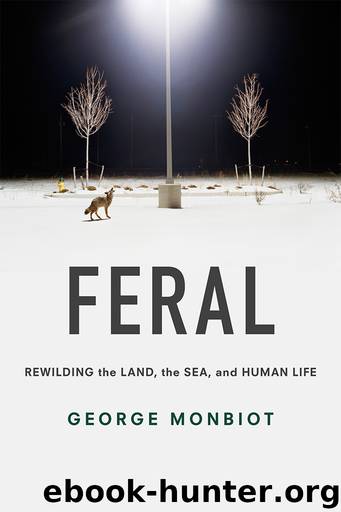Feral: Rewilding the Land, the Sea and Human Life by George Monbiot

Author:George Monbiot [Monbiot, George]
Language: eng
Format: epub
Publisher: The University of Chicago Press
10
The Hushings
. . . the smashed faces
Of the farms with the stone trickle
Of their tears down the hills’ side.
R. S. Thomas
Reservoirs
Of all the world’s creatures, perhaps those in the greatest need of rewilding are our children. The collapse of children’s engagement with nature has been even faster than the collapse of the natural world. In the turning of one generation, the outdoor life in which many of us were immersed has gone. Since the 1970s the area in which children may roam without supervision in the UK has decreased by almost 90 per cent, while the proportion of children regularly playing in wild places has fallen from over half to fewer than one in ten.1
Parents are wrongly terrified of strangers and rightly terrified of traffic. The ecosystem of the indoor world has become ever richer and more engaging. In some countries, children are now demonized and harried when they gather in public places; their games forbidden, their very presence perceived as a threat.2 But as Jay Griffiths records in her remarkable book Kith, they have also been excluded from the fortifying commons by the enclosure and destruction of the natural world.
The commons was home for boy or bird but the Enclosures*1 stole the nests of both, reaved children of the site of their childhood, robbed them of animal-tutors and river-mentors and stole their deep dream-shelters. The great outdoors was fenced off and marked ‘Trespassers Will be Prosecuted.’ Over the generations, as the outdoors shrank, the indoor world enlarged in importance.3
As Griffiths shows, enclosure, accompanied by a rapid replacement of the commoners’ polyculture with a landlord’s monoculture, destroyed much of what made the land delightful to children–the ancient trees and unploughed dells, the ponds and rushy meadows, the woods, heath and scrub–and banned them from what it failed to destroy. Destruction and exclusion have continued long beyond the nineteenth century. So many fences are raised to shut us out that eventually they shut us in.
Enclosure, Griffiths notes, also terminated the long cycle of festivals and carnivals through which people celebrated their marriage to the land, when authority was subverted and mischief made. The places where the festivals had been held were closed, fenced and policed.
In the early 1990s, I saw this excision performed with shocking speed in Maasailand. I watched the warriors of the community with which I worked perform their people’s last ceremonies–last rites–as the commons in which these had been held were privatized and wired up.4 This process of enclosure and closure shut the people out of their land almost overnight, shattered their communities, dispersed their peculiar culture and drove the young people, many of whom were now destitute, into the cities, where their contact with the natural world was permanently severed. I watched, in other words, the recapitulation of the story of my own land, and witnessed the bewilderment, dewilderment and grief it caused.
The commons belonged, inasmuch as they belonged to anyone, to children. Their trees and topography provided, uncommissioned and unbuilt, the slides and climbing frames, sandpits
Download
This site does not store any files on its server. We only index and link to content provided by other sites. Please contact the content providers to delete copyright contents if any and email us, we'll remove relevant links or contents immediately.
| Acoustics | Bridges |
| Earthwork Design | Environmental |
| Fire Science | Highway & Traffic |
| Hydrology | Remote Sensing |
| Seismic Design | Structural |
| Structural Dynamics | Surveying & Photogrammetry |
| Transportation |
Whiskies Galore by Ian Buxton(41879)
Introduction to Aircraft Design (Cambridge Aerospace Series) by John P. Fielding(33064)
Small Unmanned Fixed-wing Aircraft Design by Andrew J. Keane Andras Sobester James P. Scanlan & András Sóbester & James P. Scanlan(32743)
Craft Beer for the Homebrewer by Michael Agnew(18140)
Turbulence by E. J. Noyes(7936)
The Complete Stick Figure Physics Tutorials by Allen Sarah(7307)
Kaplan MCAT General Chemistry Review by Kaplan(6867)
The Thirst by Nesbo Jo(6826)
Bad Blood by John Carreyrou(6552)
Modelling of Convective Heat and Mass Transfer in Rotating Flows by Igor V. Shevchuk(6391)
Learning SQL by Alan Beaulieu(6211)
Weapons of Math Destruction by Cathy O'Neil(6143)
Man-made Catastrophes and Risk Information Concealment by Dmitry Chernov & Didier Sornette(5921)
Digital Minimalism by Cal Newport;(5664)
Life 3.0: Being Human in the Age of Artificial Intelligence by Tegmark Max(5474)
iGen by Jean M. Twenge(5366)
Secrets of Antigravity Propulsion: Tesla, UFOs, and Classified Aerospace Technology by Ph.D. Paul A. Laviolette(5309)
Design of Trajectory Optimization Approach for Space Maneuver Vehicle Skip Entry Problems by Runqi Chai & Al Savvaris & Antonios Tsourdos & Senchun Chai(5011)
Pale Blue Dot by Carl Sagan(4912)
